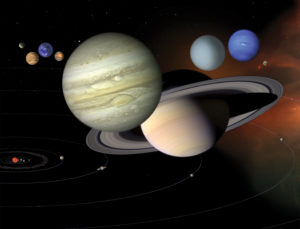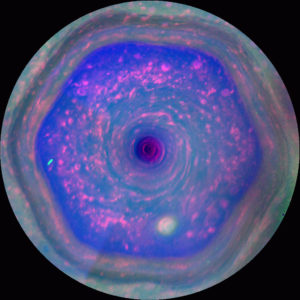Have you ever thought about what you would talk about in a conversation with an alien? We (humans) often turn to an old conversational steadfast when making small talk: weather. This reliable icebreaker has been a topic of discussion for likely as long as there have been discussions. We complain when it’s too cold/rainy/windy, or when it’s too hot/dry/calm, maybe even in the same day. And while you don’t have to be a meteorological expert to talk about it, knowing some of the ins and outs of how weather works can certainly enhance your chatting aptitude. Nowadays, we learn much about our planet’s atmosphere thanks to orbiting satellites. Whilst these satellites point down and tell us about meteorology on Earth, similar satellites and probes can tell us about the weather on other planets.

Our solar system. Image Credit: NASA/JPL-Caltech/Space Science Institute
While meteorology on Mars has its own distinct flavour, it has a great deal in common with Earth’s weather. Despite having a thinner atmosphere, the red plant still has the ability to create what would be familiar sights to us. On a lucky day, Martian cloud gazers would see something akin to the cirrus clouds that we see on Earth[i]. While atmospheric scientists believe that these clouds form through similar processes, there exists another atmospheric phenomenon that looks familiar, but thankfully does not occur here at home. Falling snow may conjure thoughts of catching snowflakes on your tongue, but you wouldn’t want to try that on Mars. The snow that falls is made of carbon dioxide flakes, or “dry-ice”, and is a chilling -125°C[ii]. Though operating at temperatures unfathomable to most, our study of Earthly snow can help us understand the formation of this dry-ice snow. But if you want to see clear examples of similarities on a larger scale, it would be best for you to travel a little further out in the solar system.
Jupiter is host to one of the most famous hurricanes in the solar system: The Great Red Spot[iii]. Great in every sense of the word, this storm is wider than the diameter of the Earth, and can even be seen with a good amateur telescope. As far as we can tell, it has been raging for hundreds of years, absolutely surpassing even the mightiest hurricanes we’ve ever seen. Information and observations that we obtain from hurricane research here at home can give insight into the dynamics governing the Great Red Spot. Unfortunately, not all knowledge gained on Earth applies directly to extra-terrestrial hurricanes. For instance, we know that the evaporation of ocean water supplies energy to Earthly hurricanes. But with Jupiter’s gaseous composition, we can be certain that no such recognisable oceans exist beneath the Great Red Spot. So, its 400 km/hour winds must be powered by some other means, a question still being researched today[iv]. And while the king of the planets has a truly majestic storm, it isn’t the only blustery giant in the solar system.

Saturn’s northern polar vortex. Image Credit: NASA/JPL-Caltech/SSI/Hampton University
Well over half a billion kilometers further out than Jupiter, lies the picturesque planet Saturn. Serene appearances hide some savage weather. Below those lovely rings rage some of the fastest winds in the solar system, clocking in at an astounding 1800 km/hour[v]. These winds can organise into jets, just like the familiar jet-stream over Earth’s mid-latitudes. However, while Earth’s jet-stream can meander in different shapes, Saturn’s northern jet-stream maintains a regular hexagonal form[vi]. Initially discovered in the 1980’s, and later re-observed in the mid 2000’s, this peculiar polygon inspired meteorologists to understand the conditions necessary to create and sustain such a jet-stream. Through laboratory simulations, atmospheric scientists propose that on an entirely gaseous planet like Saturn, the pattern was created by the interplay between the speed of the jet, and the interactions of surrounding eddies (whirlpool-like structures)[vii]. So just as investigating Earthly weather can tell us about processes occurring on other planets, delving into extra-terrestrial meteorology can shed some light on how our own atmosphere does, or does not behave.
Just imagine, your experience with weather connects you to the rest of our celestial neighbourhood, and planets well beyond. As satellite and telescope technology advances, we discover and examine more and more mind-blowing exoplanets outside of our solar system. Similarities and differences with our own planet grants us a deeper understanding of what meteorology is capable of. So by studying meteorology, you’re also studying why it snows carbon dioxide on Mars, why the winds are so wicked fast on Jupiter and Saturn, and why the atmospheres of as-of-yet undiscovered planets do the amazing things they do. That way, if you ever meet an alien, you’ll have plenty to talk about.
[i] https://gizmodo.com/nasas-curiosity-rover-captures-haunting-images-of-cloud-1797722367
[ii] https://www.jpl.nasa.gov/news/news.php?release=2012-286
[iii] https://en.wikipedia.org/wiki/Great_Red_Spot
[iv] https://www.space.com/23708-jupiter-great-red-spot-longevity.html
[v] https://www.nasa.gov/mission_pages/cassini/whycassini/planet.html
[vi] https://www.space.com/27392-saturn-hexagon-vortex-nasa-photo.html
[vii] https://www.seeker.com/saturns-north-pole-hexagon-mystery-solved-1765044584.html







